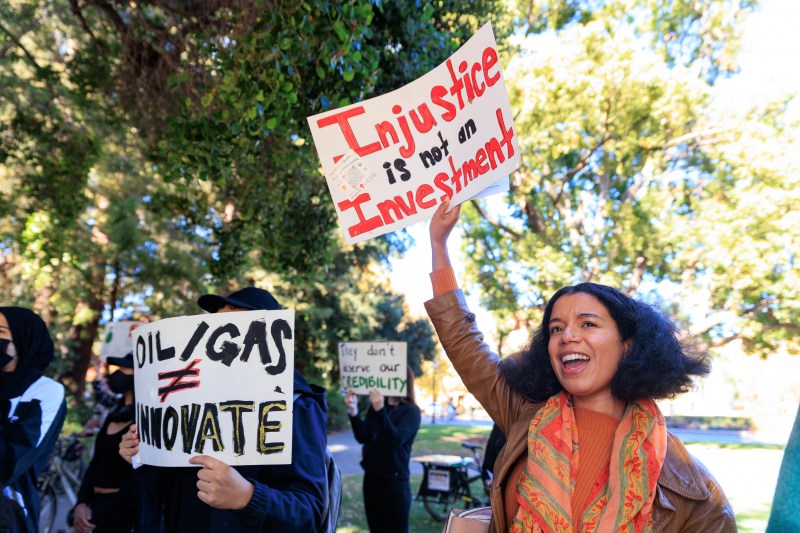Students, faculty and outside activists affiliated with the Coalition for a True School of Sustainability protested Stanford’s inclusion of ExxonMobil Chairman and Chief Executive Officer Darren Woods as a guest speaker at the Global Energy Forum and the Doerr School of Sustainability’s acceptance of fossil fuel money.
At the same event, Woods discussed Exxon’s plans to become carbon neutral by 2050.
The Coalition has organized community advocacy and protests since May, when Dean Arun Majumdar told the New York Times that the sustainability school would continue to accept research funding from oil and gas companies. This policy remains unchanged, but Majumdar is currently on a listening tour to seek out the perspectives of students and faculty in the Doerr school — a tour that has the potential to change the school’s relationship with the petroleum industry.
The protestors called on the school to reject funding from companies that continue to produce oil and gas, which they said runs counter to the goals of a sustainability school.
“This is part of our larger goal to ensure that the Doerr School of Sustainability lives up to its name and avoids influence from the fossil fuel industry,” said protest organizer Daly Wettermark M.S. ’25. Wettermark said the Doerr School’s hosting of prominent oil and gas executives, including Woods, undermines the sustainability school’s legitimacy.
“Having these partnerships, including accepting their funding, accepting their collaboration and industry-partnered research, is harming the integrity of Stanford’s research,” Wettermark said.

The Daily has reached out to the University for comment about the protest and Global Energy Forum.
The protesters — a few dozen students, professors and outside activists — began by marching from Tanner Fountain in front of Hoover Tower to the gates of the Hoover Institution, hoping to catch the attention of attendees outside after the conclusion of Woods’ event.
The Lamentors, a Bay Area environmental activist group dressed in burlap smocks with white-painted faces, joined the protesters. The only Stanford affiliate in the seven-person group, Ralph King ’80, spoke with The Daily before the protest.
“I think it’s criminal that the CEO of Exxon is allowed to speak. He’s one of the biggest climate criminals, having reported $20 billion in returns,” King said. “They are pillaging the earth.”

The protestors dyed Tanner Fountain’s water black and then marched around the Hoover Institution on Jane Stanford Way and Lasuen Mall chanting, “Exxon lies, people die,” “Hey hey, ho ho, Exxon funding’s got to go” and “Big Oil, no more, fossil fuels, out the door.”
The chants drew at least one class — COLLEGE 101: “Why College? Your Education and the Good Life” — outside to spectate. Wettermark hopes that the protesters’ message resonated with both attendees and Stanford community members.
“We’re here not out of any personal profits or motives, just because we care, because this hurts us, because we want our school to have integrity,” Wettermark said.
“It hurts us to see our school selling out to these organizations that aren’t aligned with our mission.”
The Global Energy Forum is a three-day event organized by the Precourt Institute for Energy to bring together leaders in industry, policy and Stanford energy research. Director of Projects and Technology at Shell Harry Brekelmans and Senior Vice President of Investor Relations at TotalEnergies Ladislas Paszkiewicz also spoke at the event on a panel about how their companies contribute to reducing global emissions.
Brekelmans and Paszkiewicz shared plans for their companies to become a renewable energy supplier in a panel on Wednesday, but Woods was cautious about committing Exxon to an energy transition, focusing his fireside chat Thursday on carbon capture technologies.
“We did ourselves a disservice by calling ourselves an energy company,” Woods said, expressing doubt that Exxon would become a renewable energy producer. “We’re still in the business of manipulating hydrogen and carbon molecules.”

Instead, Woods was enthusiastic about Exxon’s future role in removing carbon dioxide from the atmosphere. “We know how to run pipelines, we know how to run CO2 facilities, we know how to build those facilities,” he said. Woods called for a government-set price on carbon to increase demand for sequestered carbon, saying that governments should “put a price that’s transparent, stable and consistent [on carbon dioxide].”
Some forum attendees stepped outside to see the protest during an intermission following Wood’s talk.
Akshath Sahni Ph.D. ’98 and general manager of strategy at Chevron told The Daily he thought that the demonstrator’s characterization of the oil and gas industry was inaccurate. “We’re scientists and engineers. At the end of the day, we want these technologies to work, and we want multiple entities — academic, corporate and even government — solving this problem,” Sahni said.
However, Sahni also recognized that the protest showed a positive sign of serious engagement within the Stanford community: “It’s good to ask questions, it’s good to challenge the incumbency, as long as there is a healthy dialogue.”
Nikolas Liepins contributed reporting to this article.
